Tessa’s Recipe Rundown
Taste: The PERFECT quintessential pretzel flavor.
Texture: Slightly crisp at the edges but chewy throughout.
Ease: Truly easier than you think. Once you’ve made them a couple times, you can make a full batch in 1 hour from start to finish.
Pros: No rising time! Absolutely delicious.
Cons: For the most authentic pretzels, a lye bath will provide the best results which can be a bit of a hassle.
Would I make this again? We make these every other week.
This post may contain affiliate links. Read our disclosure policy.
Whether it’s Oktoberfest, the Super Bowl, or you’re just in the mood, these German-inspired pretzels are shockingly easy to make! Once you get your pretzel shaping technique down (tips on that below), they seriously take less than 1 hour to make from start to finish.
That’s because there’s basically no rising time! Which means you could make them Sunday morning for the football game that afternoon… if that’s your thing. To be honest, the only part about football I care about is the snacks.
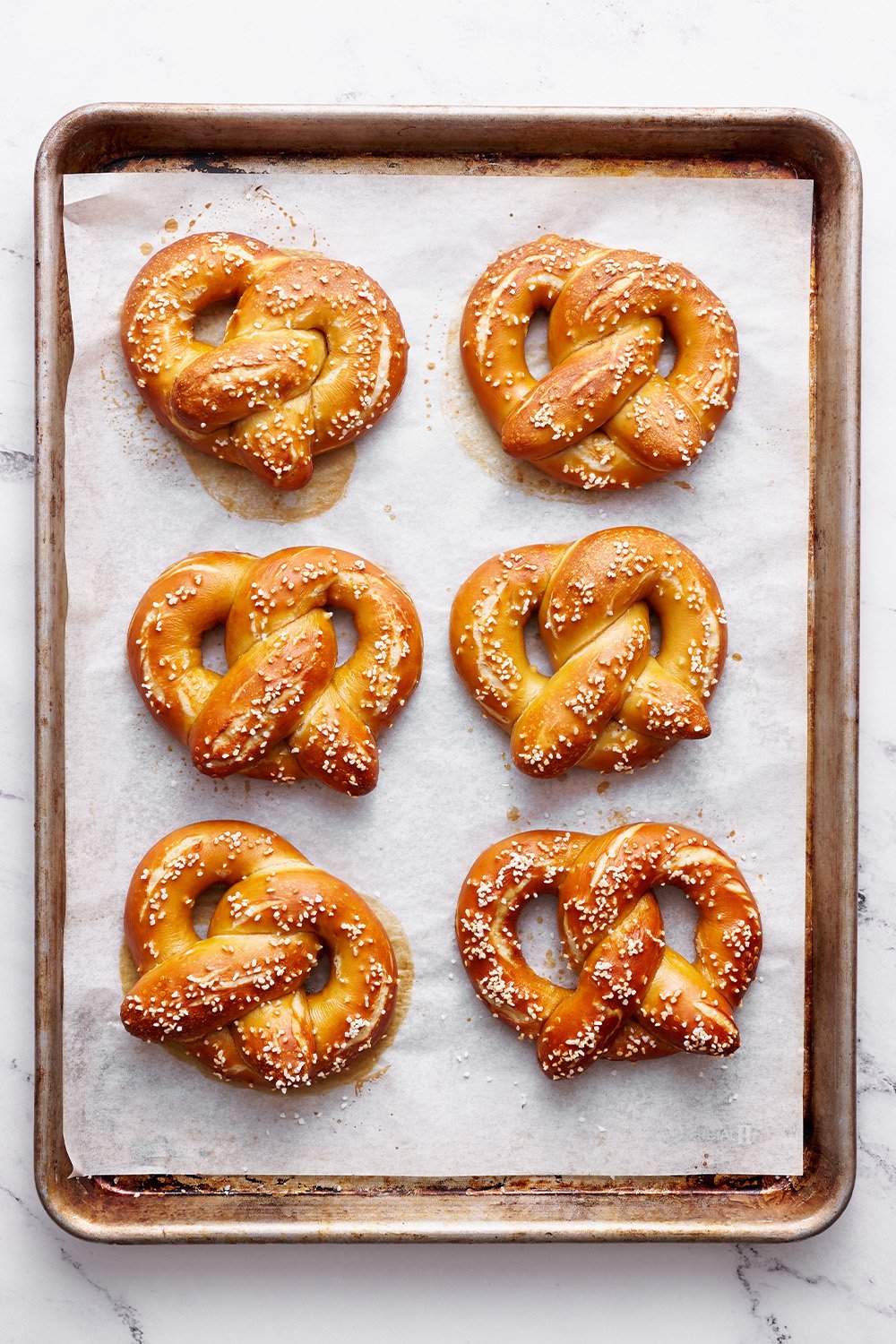
I can’t take credit for this soft pretzel recipe. It was actually developed by my boyfriend, Joe, years before we began dating. He was inspired by a backpacking trip to Germany in his early 20s where he had his first authentic Bavarian pretzel and discovered how different they are from American mall pretzels.
When he asked how and why their pretzels are so different from American ones, so deeply browned and flavorful, he discovered authentic pretzels are bathed in a lye solution before baking. It makes a HUGE difference, which I’ve detailed below (including an alternative to the lye)!

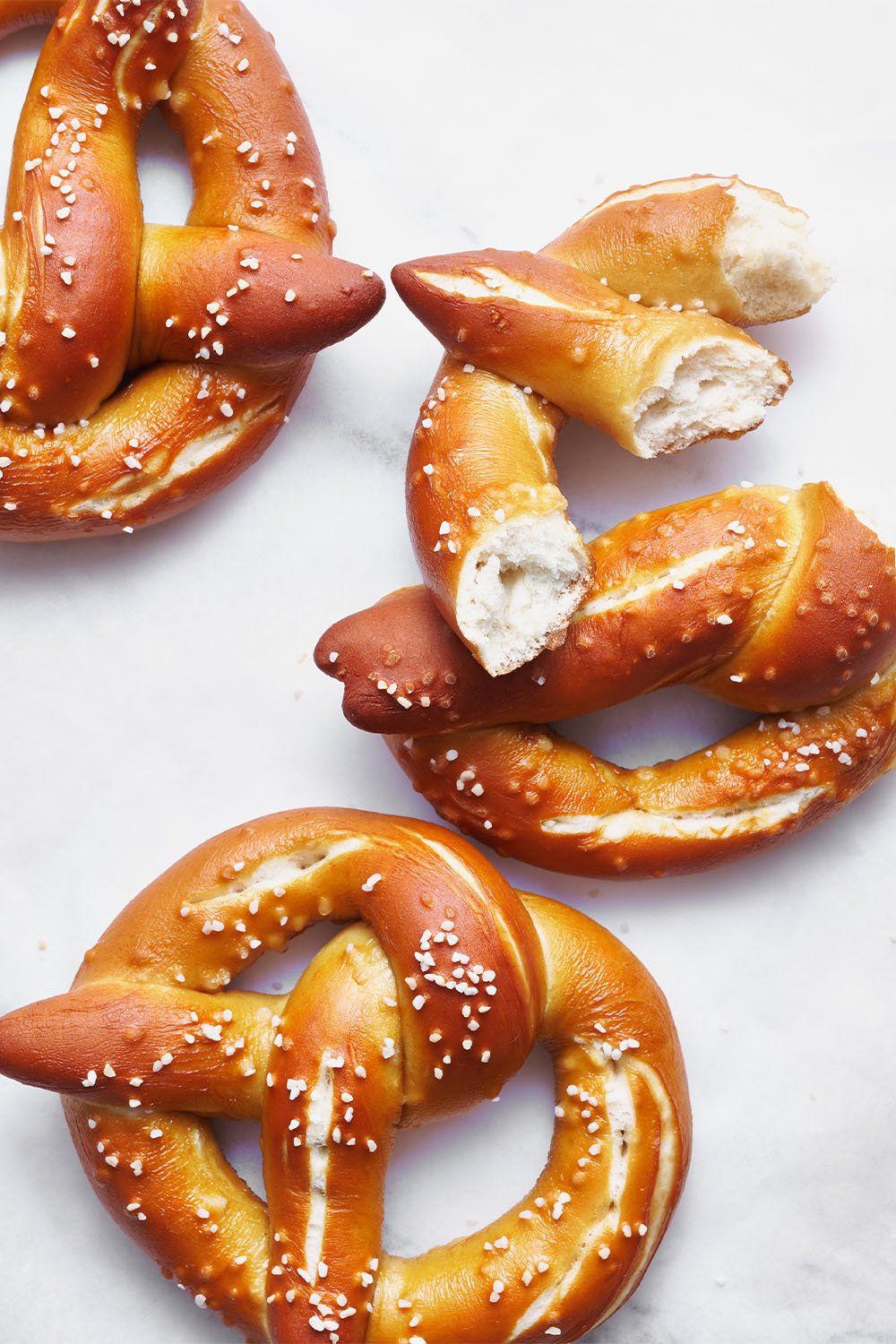
We worked together for weeks to test out the pretzel recipe to document it in detail in order for Handle the Heat bakers to recreate them in their own home kitchens. Below you’ll find practically everything you could ever want to know about baking the best pretzels of your life.
How to Make Soft Pretzels
Ingredients for Homemade Pretzels Recipe:
- Active dry yeast – You can use instant yeast instead, but note that your pretzels may just be slightly more fluffy than chewy. Read our blog post on active dry vs. instant yeast.
- Barley malt syrup – This helps give the pretzels that distinct deep yet slightly bittersweet flavor. I ordered online, but have also seen it at some health food stores. If you can’t find this, simply use brown sugar (light or dark – the difference won’t be noticeable as it’s a small amount).
- All-purpose flour – I’ve tested this recipe with bread flour and didn’t find that it made enough of a positive impact to recommend using it instead. AP works great here! To be specific, I tested with bleached Gold Medal AP flour. I’ve also very successfully tested this recipe swapping in 2 cups of Rye flour for AP flour which adds a lovely depth of flavor and even darker color!
- Fine sea salt – This is for the dough.
- Pretzel salt – This is for sprinkling on the pretzels before baking. I’d highly recommend ordering the pretzel salt for the most impressive pretzels possible and best flavor. If that’s not an option, use coarse sea salt instead. Just note it’ll dissolve into the dough more.
- Food grade lye – More on this below.
How to Knead Soft Pretzel Dough:
I like to use my 6-quart Professional KitchenAid stand mixer with the dough hook attachment. This dough is quite stiff and dense, so if your stand mixer is on the small side or quite old, the motor may not want to knead it. You could always knead the dough by hand, it’ll just take some upper body strength and a few more minutes.
The Key to Perfect Pretzels? Lye!
Take a look at the pretzel comparison below. One was made by dipping the unbaked pretzels in a lye bath, the other by dipping in a boiled baking soda bath:

You can see just how much darker the lye pretzels turn out! What you can’t see is they also have that distinct, slightly alkaline pretzel flavor and a chewier texture.
Lye has a pH of around 13 whereas baking soda has a pH of around 8. This extra alkalinity accelerates the Maillard reaction, allowing that caramelization to develop on the exterior of the pretzels. That ultra-deep color and slightly crispy, crunchy exterior crust is only made possible with lye. Lye is what professional bakers use, and it’s what’s authentic in a traditional Bavarian pretzel!
Do I Have to Use Lye?
No. You can prepare a baking soda bath instead. See more directions below. But if you want the most perfect pretzels possible, give lye a try! It’s not as scary as you may think.
Where to Buy Food-Grade Lye?
I know I just said not to be afraid of lye, but it is sodium hydroxide (also called caustic soda) which is the main ingredient in soap making and in products like Draino.
You can purchase food-grade lye most easily online or at some craft and hobby stores in the soap-making section.
How to Use Lye Safely
Lye is a caustic material, meaning if used improperly, it can cause chemical burns. Before you freak out, check out the safety tips below, and also remember that lye in this recipe’s application is diluted and therefore is similar to household bleach. Once lye is baked, it’s totally safe to eat.
- Only use in a well-vented controlled area. You don’t want to do this in a small space without a window open or the fan on (blowing any fumes away).
- Always add lye to water, never water to lye. The idea is to avoid any potential for splashing.
- Use only heat-resistant plastic or glass containers to prepare your lye bath. Never use metal.
- If lye does touch your clothes, remove that clothing item. If it touches your skin, simply run the skin under running water for a few minutes.
- If you’re concerned about safety, use plastic gloves when handling the pretzels in the lye bath. For extra security, feel free to wear goggles and even a face mask (now that we all own one!).
How to Prepare a Lye Bath for Pretzels:
- In a well-vented area, place a plastic or glass container (do not use metal) on top of a few pieces of parchment paper to protect your counter from splashes.
- Carefully sprinkle the lye into the water. Use a heat-safe silicone spatula to carefully stir the lye to dissolve. The lye is dissolved when the water looks clear (the container will feel warm to the touch – this is normal).
- Dip a shaped pretzel into the lye bath for about 30 seconds. Remove and let drip off then place on the prepared greased parchment-lined baking sheets.
If you wind up making pretzels often, you may want to avoid using the same glass container each time. Lye is corrosive and will eventually weaken the glass. Your best bet is a dedicated high-quality plastic container.




How to Prepare a Baking Soda Bath (lye alternative):
If working with lye isn’t an option for you, here are the directions for using baking soda instead. You simply dip the pretzels in boiling water that’s been alkalized with baking soda. Note that the pretzels will be much lighter in color and won’t have the same chewy texture.
For Baking Soda Bath:
- 2/3 cup of baking soda
- 10 cups of water
Directions: In a large pot, bring the baking soda and water to a boil. Boil the pretzels in small batches in the soda solution for about 45 seconds to 1 minute, pressing them down to submerge. Proceed with the recipe as written after the lye bath step.
Making Baking Soda More Alkaline
There are some ‘hacks’ online for baking the baking soda to increase its pH level from 8 to about 11. This is done by spreading the baking soda on a baking sheet and baking at 250°F for 2 hours. I don’t prefer this method because it’s time-consuming and the resulting baking soda is now caustic and corrosive. You may as well use lye, which is easy to order online.
Choose Your Own Pretzel Adventure:
As I see it, there are TWO pretzel journeys, aka options for customizing your soft pretzels.
- One is what’s pictured in these photos: A more traditional Bavarian-style pretzel with a deeply browned exterior and chewy texture. The recipe as written will yield this result.
- The other is a more American-ized pretzel that’s lighter in color and fluffier in texture. A pretzel reminiscent of those frozen pretzels many of us grew up eating or even the shopping mall pretzels.
- If you prefer the latter, use a baking soda bath instead of lye. You can also allow the shaped pretzels to rise for about 30 minutes before dipping in baking soda and baking. This will create a fluffier texture (but also less distinct pretzel shapes).
- For a last option on this journey, brush the freshly baked pretzels with melted butter.
How to Shape Pretzels:
Shape the log into a letter U. Cross the arms placing one over the other, then twist them around each other once. Bring the ends down to the bottom of the U and gently press to stick. Place on two greased parchment-lined baking sheets.
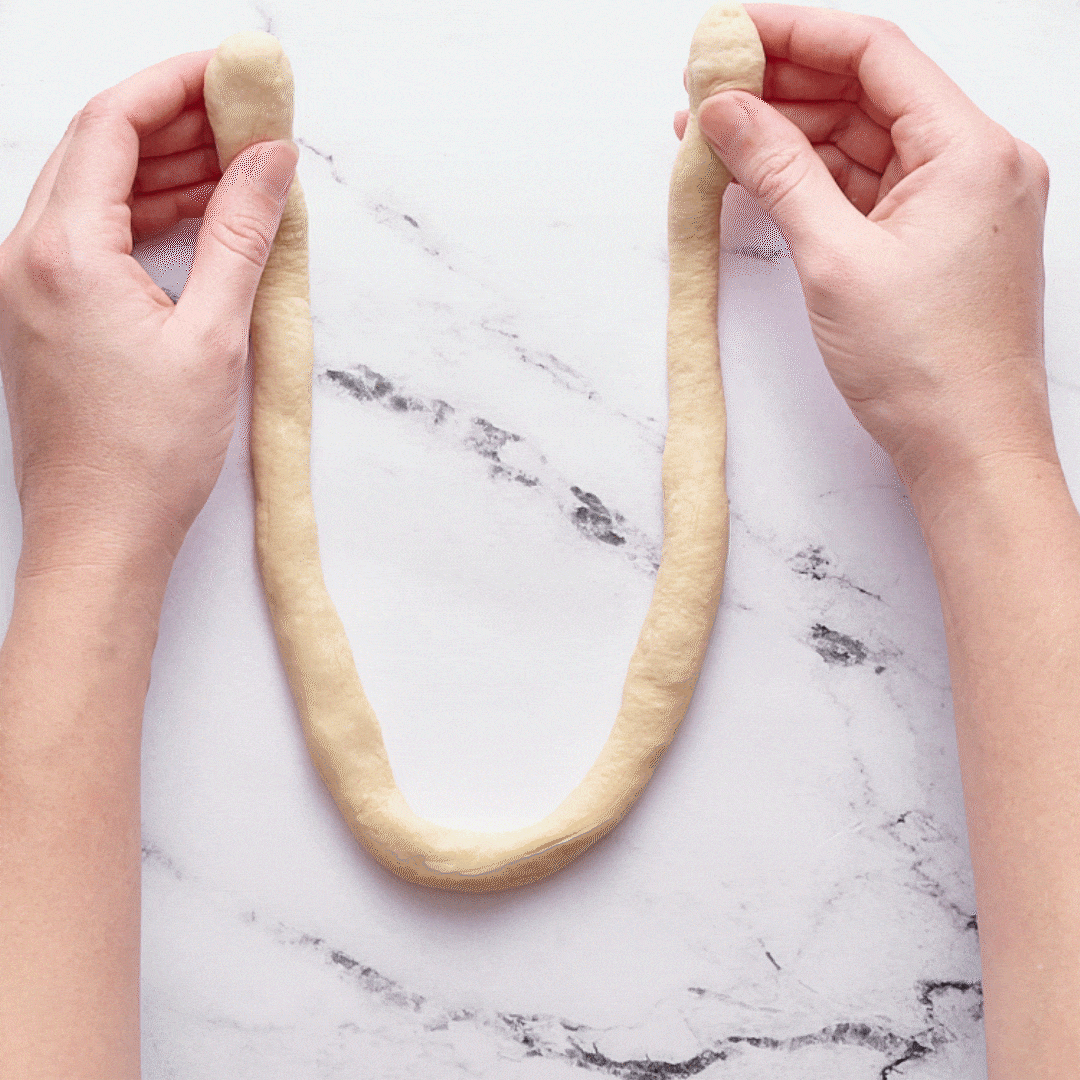
How to Make Pretzel Buns:
After you portion the dough into ten equal pieces, take one piece and begin to grab bits of the dough from the top to bring around to the bottom to create a smooth ball shape. Roll around on a clean counter to smooth out further. Bake as the recipe states.
How to Serve Pretzels:
Serve them with my Beer Cheese Dip or simply alongside some whole grain mustard or spicy honey mustard.
You can also slice pretzels open, toast them, and smear them with cream cheese for a pretzel-bagel situation.
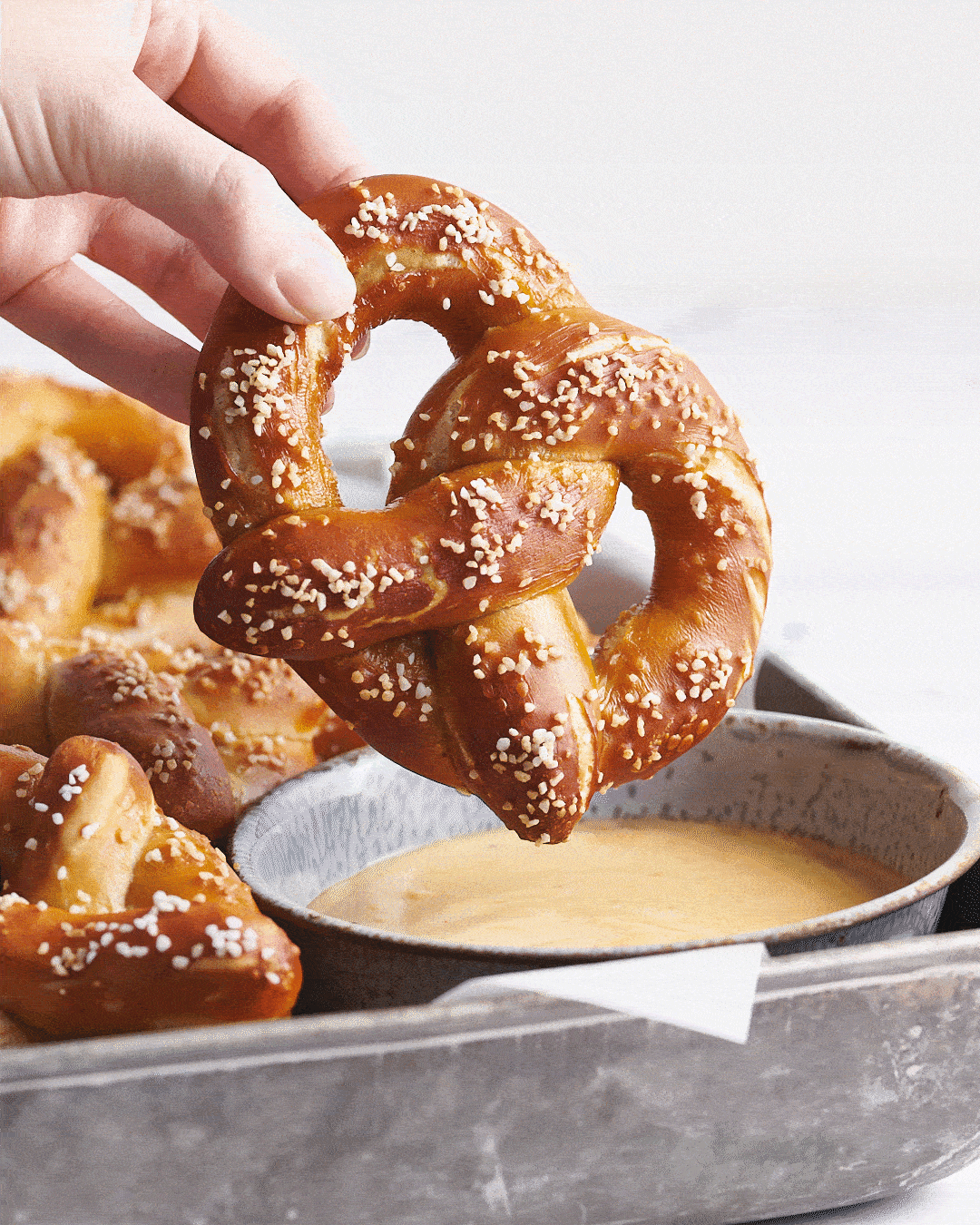
How to Store Pretzels:
Store in an airtight container at room temperature for up to 2 days. Reheat in the toaster oven at 350°F for a few minutes to refresh.
How to Freeze Pretzels (best option!):
Store the baked pretzels in an airtight container in the freezer for up to 2 months. The longer they’re frozen, the more the pretzel salt will dissolve into the pretzels, but they’ll still taste great.
Defrost by letting them sit on the counter for about an hour. Or, simply microwave for about 30 seconds. If desired for a crispier texture, once defrosted, refresh in the toaster oven for about 5 minutes.

More Recipes You’ll Love:
- No Knead Pizza Dough
- 5 Ways to Shape Bread Rolls
- Soft Pretzel Bites
- Cinnamon Sugar Pretzel Bites
- Garlic Parmesan Soft Pretzels
- Homemade Burger Buns

Homemade Pretzel Recipe
Ingredients
For the pretzels:
- 1 tablespoon active dry yeast
- 1 tablespoon
barley malt syrup or light brown sugar - 1 1/2 cups (355 grams) warm water (about 110°F), divided
- 5 cups (635 grams) all-purpose flour
- 3/4 teaspoon fine salt
For the lye bath:
- 2 tablespoons
(40 grams) food grade lye, see notes for baking soda alternative - 1 liter (1000 grams) water, room temperature
Pretzel salt or coarse salt
Instructions
- Preheat the oven to 400°F. Line two baking sheets with parchment paper or silicone baking mats. Spray with nonstick cooking spray or grease with butter.
Make the dough:
- In the bowl of a stand mixer fitted with the dough hook, combine the yeast, barley malt syrup/sugar, and 1/4 cup of the water. Whisk to combine. Let stand for 5 minutes or until frothy.
- Add the remaining 1 1/4 cups water, flour, and salt, and stir to combine. Mix on low speed until combined.
- Increase speed to medium and knead for five minutes until the dough is elastic and smooth and doesn’t stick to the sides of the bowl or your hands, adding more flour if needed. This will be a very dense dough, so be careful not to step away from your mixer in case it decides to jump on the counter.
Shape the pretzels:
- There is no need to allow this dough to rise. Remove the dough to a clean work surface (do not flour). Divide into 10 equal pieces (each should be about 100 grams). Roll each piece against the counter or between your palms into about a 24-inch long log. The thinner the log, the crispier the pretzels. The thicker, the softer the pretzels.
- Shape the log into a letter U. Cross the arms placing one over the other, then twist them around each other once. Bring the ends down to the bottom of the U and gently press to stick. Place on two greased parchment-lined baking sheets.
- If you prefer softer spongier pretzels, allow the shaped pretzels to rise for 30 minutes before bathing in the lye.
Prepare the lye bath:
- Refer to the safety disclaimer in the blog post before using lye. If lye isn’t an option, see the baking soda bath directions below. Place safety gloves and goggles on, and a face mask too if you prefer. In a well-vented area, place a plastic or glass container (do not use metal) on top of a few pieces of parchment paper to protect your counter from splashes. Carefully sprinkle the lye into the water. Use a silicone spatula to carefully stir the lye to dissolve. The lye is dissolved when the water looks clear.
- Dip a shaped pretzel into the lye bath for about 30 seconds. Remove to the prepared greased parchment-lined baking sheets. Use a paring knife to score two slices into the thickest part of each pretzel. Sprinkle with pretzel salt as desired. Repeat until all pretzels have been lye dipped, scored, and salted.
Bake the pretzels:
- Bake both trays at 400°F for about 16 minutes, alternating the trays halfway through the baking time for even baking, until deeply golden brown. Bake for less time for softer pretzels and more time for crispier pretzels.
- Let cool for 5 minutes before peeling away from the parchment paper. Serve warm or at room temperature the same day you bake the pretzels. To store, freeze the pretzels in an airtight container for up to 1 month.
Recipe Notes
Baking Soda Bath Alternative
If working with lye isn’t an option for you, here are the directions for using baking soda instead. Note that the pretzels will be much lighter in color and won’t have the same chewy texture. Ingredients for baking soda bath:- 2/3 cup of baking soda
- 10 cups of water
This recipe was published in 2021 and has been updated with additional baking tips. Photos by Joanie Simon.
January 2022 Baking Challenge
This recipe was the January 2022 selection for our monthly baking challenge! Every month you can join the challenge by baking the recipe and snapping a photo for a chance to win prizes! Learn more about my monthly baking challenges here. Check out everyone’s pretzels:





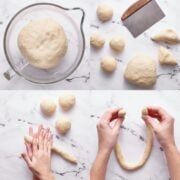












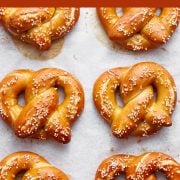





















This recipe is amazing. I made them with and without the lye bath. They are waaay better with the lye bath. I didn’t have barley syrup and used sugar instead and they still came out great. I’m gunna get some and try them again to see the difference. I let mine rise for 30 min for softer texture. My German girlfriend says they are perfect and remind her of home. She absolutely loves them.
We made these today in our Science in Cooking class today! The kids loved them and rated them a 10 on a 1-10 scale! We did it today with the baking soda bath but are planning to try it again with a sodium hydroxide bath so that they can compare what a stronger base does to the texture of the pretzel. We only added one step: with 2 minutes to go, we brushed them with melted butter! We will continue to use for this class! (And I’m planning to make with my daughter at home!) This is my second recipe from your site this week and I’m so impressed that I’ve saved it on my bookmarks page as a trusted source for great recipes! Thank you!
Made these today. Turned out great. Spent years in the suburbs of Philadelphia where soft pretzels are a thing. Mine made as per this Rx compared well with the best of those in yesteryear.
I used Gold Medal AP flour, Eden Barley Malt Syrup and a NaOH bath. I mixed the dough (~56% hydration a’la the Rx) with an Ankarsrum mixer at half speed for 8 min continuously using the scraper and roller. Piece of cake for the Ankarsrum.
I converted the rest of volumetric Rx to metric (grams) as follows: Fleischman’s Active dry yeast 14g (1 Tbsp); Salt 4g (3/4) tsp; barley malt syrup 21g (1 tbsp). Subtotal of mixed dough 1,014 (1,030 theoretical) owing to drying during mixing.
Each pretzel was formed into a 24″ rope with 100-101g dough. Dipped pretzels after 30 min rise in 1M NaOH solution (40g food grade NaOH/1,000g water) for 30 sec. Our small, old oven (circa 1987), though conventional is a fast oven; pretzel baked fully in 12 min with internal temp >200°F or greater (Thermoworks Thermoprobe Instant read).
A retired Ph.D. organic chemist, I had no difficulty handling the NaOH bath; used a plastic container and wore disposable gloves. Fully diluted the residual base solution into sink drain (No worse for drain than conventional Drain-O).
I really don’t understand the need for the slashes in the dough before baking. If the pretzel roll out length was say 16″ instead of 24″, then the pretzel would be short and fat; maybe then a slash would make sense.
The finished pretzels (10) weighed 937g or about 94g each with the sea salt. The actual calories/gram is 2.59. So a typical 94g pretzel would be 243 cals/each. Since this was a first time making them, it took about 1hr 45min. I baked two sheets of 5 pretzels each.
I will make a double batch for freezing, if and when I do it again. This would be no problem for the Ankarsrum mixer. Even a single batch would destroy a KitchenAid stand mixer, if one did not stop the mixer every two minutes to ovoid overheating,
and if one went over speed #2.
We eat them with mustard. I also ate one with Pancho Cheese dip. Darn good. Will make again. Will also try substituting in some rye flour.
Delicious with the baking soda bath! I would definitely let them rise the optional 30 minutes for a less dense pretzel 🙂
OMG!!!! Just made these pretzels today using the lye method and they are so amazing!!!! 😲 They taste just like the ones at the mall or fair! I did however use bread flour because I do not have any AP flour. Amazing and excellent how well the turned out!!! 😁
Yay! So glad to hear that these pretzels worked so well for you!! Thanks so much for the comment 🙂
The taste and texture of these turned out to be exactly what I was looking for-bit more dense and not totally soft.
However, I do have a question: I was unable to get the dough to roll very well and ended up just kind of squeezing it to make the long “rope”. Do you suppose I should have added more water or less flour?? It just wanted to slide across my counter rather than roll like every other pretzel I have worked with.
Thank you!
Hi there! So happy to hear that you enjoyed the flavor and texture of these pretzels! The way you’re describing shaping your pretzels is totally fine if that is working for you!
You also could be adding a little too much flour if you use measuring cups to measure your flour (learn more about that here). Also be sure you’re not flouring your countertops when shaping the dough, as that will also add excess flour and we want to avoid that! Also, not flouring the counters allows your dough to gain a little traction, making it easier to roll the logs against the counter, if that’s easier for you than rolling between your palms. If that doesn’t help, you can also try covering the dough with a kitchen towel for 10-15 minutes to allow the gluten to relax a little, before continuing with dividing and shaping the dough. I hope that helps! Happy baking 🙂
I found the same issue when I tried to roll the first one. I misted/spritzed each dough ball and the countertop with water. This made the dough/counter sticky enough, but not too sticky. To get the dough rope started try rolling first between your palms letting the forming rope hang down betwen them. After it is partially formed, lay the rope on the damp, not wet, countertop and continue. Once I got the hang of this, I was able to roll and form 5 pretzels in 8 minutes.
Using a magic marker, I put two dots on the countertop 24″ apart, which made getting the proper length a snap.
What does one do with the lye bath water after all dipping is through? Pour down a slop sink? Pour into the sewer?
Hi Michael! Disposing of your lye bath depends a little on your home and plumbing. If you live in a newer house or place with good pipes, feel free to dispose of the lye by pouring it down your sink, and then run water for a minute or two to be sure it keeps moving and gets flushed out. If you don’t live somewhere with city water, have old pipes, or have well water, septic tank, etc, then your best bet would be to dispose of it in a small sealed plastic container. I hope that helps! Let us know what you think of these pretzels once you have given them a try 🙂 Happy Baking!
Hi! I’m a chemist. I would definitely not pour the solution directly down your kitchen sink–it’s 1M. You can use about 1.2 L of distilled white vinegar to neutralize it, and then you can just pour it down any drain. Hope this helps!
Consider Drano drain cleaner. A 1M solution of NaOH is a lot more dilute than a dose of Drano, which does no harm to pipes or septic systems. Just use plenty of water (the solution to pollution is dilution.)
I’m making this for a second time and this was so tasty but the dough is incredibly difficult for me to stretch out. Is this typical or am I doing something wrong?
Hi Kristy! I’m glad to hear that you enjoy these pretzels! The dough can be a little tough to handle if you’re not used to handling yeasted doughs. Some people find it easier to press the dough into a long piece, and then roll the long pressed-out piece into a log-shape from there – so you’re pressing more than pulling/stretching. If that doesn’t help, you can cover the dough with a kitchen towel for 10-15 minutes to allow the gluten to relax a little, before shaping the dough. I hope that helps! Happy baking 🙂
I have a question, could I use this recipe for pretzel bites? Tessa has a great pretzel bite recipe, but it uses the baking soda bath, I would love to try using the lye bath.
Thank you!
Mary Jane
Hi Mary Jane! I don’t believe Tessa has tried this recipe in bite-size, but I don’t see why that wouldn’t work just fine! You’ll need to experiment with the bake time and lower it due to the smaller size, but that should be the only adjustment needed. Let us know how it goes! 🙂
Can I use this recipe to make 12”-16” pretzels too?
Hi Jerry! We haven’t tried that, but it should work – you’ll just need to adjust the bake time. Let us know how it goes if you give that a try 🙂